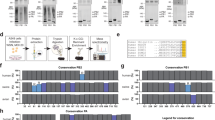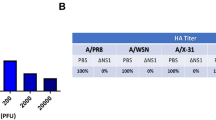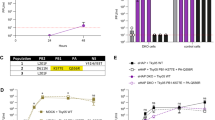Abstract
The influenza A virus is a causative agent of influenza, which infects human cells and uses host factors to accomplish viral genome replication as part of its life cycle. The nucleoprotein (NP) and PB2 of the influenza virus associate with importin α1 to gain access to the host nucleus through a ternary import complex. Killer cell-mediated cytotoxicity is the primary mechanism of eliminating the influenza virus. Here, we showed that lymphokine-activated killer cells participated in the elimination of the influenza virus. Granzyme (Gzm) K inhibition elevated viral replication in vitro and aggravated viral infection in vivo. We identified that importin α1 and its transport partner protein importin β are physiological substrates of GzmK. Proteolysis of these two substrates wrecked their association to generate the importin α1/β dimer and disrupted transportation of viral NP to the nucleus, leading to inhibition of influenza virus replication.
Similar content being viewed by others
Log in or create a free account to read this content
Gain free access to this article, as well as selected content from this journal and more on nature.com
or
Abbreviations
- Ad:
-
replication-deficient adenovirus type V
- ARM:
-
armadillo
- ERG:
-
energy regeneration system
- Gzm:
-
granzyme
- HEAT:
-
Huntington, elongation factor 3, PR65/A, TOR
- IBB:
-
the importin β-binding (IBB) domain of Impα1
- IBN-NT:
-
the importin β N-terminal domain
- Impα1:
-
importin α1/karyopherin α2
- Impβ:
-
importin β/karyopherin β1
- rImp:
-
recombinant importin
- KI:
-
GzmK inhibitor
- NP:
-
nucleoprotein
- WT:
-
wild-type
References
Mattaj IW, Englmeier L . Nucleocytoplasmic transport: the soluble phase. Annu Rev Biochem 1998; 67: 265–306.
Gabriel G, Herwig A, Klenk HD . Interaction of polymerase subunit PB2 and NP with importin alpha1 is a determinant of host range of influenza A virus. PLoS Pathog 2008; 4: e11.
Fan Z, Zhang Q . Molecular mechanisms of lymphocyte-mediated cytotoxicity. Cell Mol Immunol 2005; 2: 259–264.
Chowdhury D, Lieberman J . Death by a thousand cuts: granzyme pathways of programmed cell death. Annu Rev Immunol 2008; 26: 389–420.
Fan Z, Beresford PJ, Oh DY, Zhang D, Lieberman J . Tumor suppressor NM23-H1 is a granzyme A-activated DNase during CTL-mediated apoptosis, and the nucleosome assembly protein SET is its inhibitor. Cell 2003; 112: 659–672.
Topham DJ, Tripp RA, Doherty PC . CD8+ T cells clear influenza virus by perforin or Fas-dependent processes. J Immunol 1997; 159: 5197–5200.
Regner M, Pavlinovic L, Koskinen A, Young N, Trapani JA, Mullbacher A . Cutting edge: rapid and efficient in vivo cytotoxicity by cytotoxic T cells is independent of granzymes A and B. J Immunol 2009; 183: 37–40.
Jenkins MR, Trapani JA, Doherty PC, Turner SJ . Granzyme K expressing cytotoxic T lymphocytes protects against influenza virus in granzyme AB-/- mice. Viral Immunol 2008; 21: 341–346.
Bratke K, Kuepper M, Bade B, Virchow Jr JC, Luttmann W . Differential expression of human granzymes A, B, and K in natural killer cells and during CD8+ T cell differentiation in peripheral blood. Eur J Immunol 2005; 35: 2608–2616.
Zhao T, Zhang H, Guo Y, Zhang Q, Hua G, Lu H et al. Granzyme K cleaves the nucleosome assembly protein SET to induce single-stranded DNA nicks of target cells. Cell Death Differ 2007; 14: 489–499.
Guo Y, Chen J, Zhao T, Fan Z . Granzyme K degrades the redox/DNA repair enzyme Ape1 to trigger oxidative stress of target cells leading to cytotoxicity. Mol Immunol 2008; 45: 2225–2235.
Zhao T, Zhang H, Guo Y, Fan Z . Granzyme K directly processes bid to release cytochrome c and endonuclease G leading to mitochondria-dependent cell death. J Biol Chem 2007; 282: 12104–12111.
Guo Y, Chen J, Shi L, Fan Z . Valosin-containing protein cleavage by granzyme K accelerates an endoplasmic reticulum stress leading to caspase-independent cytotoxicity of target tumor cells. J Immunol 2010; 185: 5348–5359.
Hua G, Wang S, Zhong C, Xue P, Fan Z . Ignition of p53 bomb sensitizes tumor cells to granzyme K-mediated cytolysis. J Immunol 2009; 182: 2152–2159.
Harari A, Enders FB, Cellerai C, Bart PA, Pantaleo G . Distinct profiles of cytotoxic granules in memory CD8 T cells correlate with function, differentiation stage, and antigen exposure. J Virol 2009; 83: 2862–2871.
Toyoda T, Hara K, Imamura Y . Ser624 of the PA subunit of influenza A virus is not essential for viral growth in cells and mice, but required for the maximal viral growth. Arch Virol 2003; 148: 1687–1696.
Bovenschen N, Quadir R, van den Berg AL, Brenkman AB, Vandenberghe I, Devreese B et al. Granzyme K displays highly restricted substrate specificity that only partially overlaps with granzyme A. J Biol Chem 2009; 284: 3504–3512.
Zhang J, Rubio V, Lieberman MW, Shi ZZ . OLA1, an Obg-like ATPase, suppresses antioxidant response via nontranscriptional mechanisms. Proc Natl Acad Sci USA 2009; 106: 15356–15361.
Goldfarb DS, Corbett AH, Mason DA, Harreman MT, Adam SA . Importin alpha: a multipurpose nuclear-transport receptor. Trends Cell Biol 2004; 14: 505–514.
Wang P, Palese P, O’Neill RE . The NPI-1/NPI-3 (karyopherin alpha) binding site on the influenza a virus nucleoprotein NP is a nonconventional nuclear localization signal. J Virol 1997; 71: 1850–1856.
Lott K, Cingolani G . The importin beta binding domain as a master regulator of nucleocytoplasmic transport. Biochim Biophys Acta 2010; 1813: 1578–1592.
Cingolani G, Petosa C, Weis K, Muller CW . Structure of importin-beta bound to the IBB domain of importin-alpha. Nature 1999; 399: 221–229.
Cros JF, Palese P . Trafficking of viral genomic RNA into and out of the nucleus: influenza, Thogoto and Borna disease viruses. Virus Res 2003; 95: 3–12.
Doherty PC, Topham DJ, Tripp RA, Cardin RD, Brooks JW, Stevenson PG . Effector CD4+ and CD8+ T-cell mechanisms in the control of respiratory virus infections. Immunol Rev 1997; 159: 105–117.
Jenkins MR, Kedzierska K, Doherty PC, Turner SJ . Heterogeneity of effector phenotype for acute phase and memory influenza A virus-specific CTL. J Immunol 2007; 179: 64–70.
Vivier E, Raulet DH, Moretta A, Caligiuri MA, Zitvogel L, Lanier LL et al. Innate or adaptive immunity? The example of natural killer cells. Science 2011; 331: 44–49.
Fan Z, Yu P, Wang Y, Fu ML, Liu W, Sun Y et al. NK-cell activation by LIGHT triggers tumor-specific CD8+ T-cell immunity to reject established tumors. Blood 2006; 107: 1342–1351.
Voskoboinik I, Smyth MJ, Trapani JA . Perforin-mediated target-cell death and immune homeostasis. Nat Rev Immunol 2006; 6: 940–952.
Bovenschen N, Kummer JA . Orphan granzymes find a home. Immunol Rev 2010; 235: 117–127.
Bade B, Lohrmann J, ten Brinke A, Wolbink AM, Wolbink GJ, ten Berge IJ et al. Detection of soluble human granzyme K in vitro and in vivo. Eur J Immunol 2005; 35: 2940–2948.
Martinvalet D, Zhu P, Lieberman J . Granzyme A induces caspase-independent mitochondrial damage, a required first step for apoptosis. Immunity 2005; 22: 355–370.
Lange A, Mills RE, Lange CJ, Stewart M, Devine SE, Corbett AH . Classical nuclear localization signals: definition, function, and interaction with importin alpha. J Biol Chem 2007; 282: 5101–5105.
Kelley JB, Talley AM, Spencer A, Gioeli D, Paschal BM . Karyopherin alpha7 (KPNA7), a divergent member of the importin alpha family of nuclear import receptors. BMC Cell Biol 2010; 11: 63–74.
Mahrus S, Craik CS . Selective chemical functional probes of granzymes A and B reveal granzyme B is a major effector of natural killer cell-mediated lysis of target cells. Chem Biol 2005; 12: 567–577.
Acknowledgements
We thank Dr. Domenico Delia for providing us with importin α1 plasmid and Dr. Xuemei Li for the NP plasmid. We also thank Peng Xue, Zhensheng Xie, Yan Teng, and Chunchun Liu for their technical support. This work was supported by the National Natural Science Foundation of China (30830030, 30972676), 973 Programs (2010CB911902), and the Innovative Program of CAS (XDA01010407, KSCX2-YW-R-42).
Author information
Authors and Affiliations
Corresponding author
Ethics declarations
Competing interests
The authors declare no conflict of interest.
Additional information
Edited by S Kornbluth
Author contributions
CZ designed, performed research, analyzed data, and wrote the paper; CL and XW performed some research experiments; TT and GG analyzed data; and ZF initiated the study, designed, organized, and wrote the paper.
Supplementary Information accompanies the paper on Cell Death and Differentiation website
Supplementary information
Rights and permissions
About this article
Cite this article
Zhong, C., Li, C., Wang, X. et al. Granzyme K inhibits replication of influenza virus through cleaving the nuclear transport complex importin α1/β dimer of infected host cells. Cell Death Differ 19, 882–890 (2012). https://doi.org/10.1038/cdd.2011.178
Received:
Revised:
Accepted:
Published:
Issue date:
DOI: https://doi.org/10.1038/cdd.2011.178
Keywords
This article is cited by
-
Perforin and granzymes: function, dysfunction and human pathology
Nature Reviews Immunology (2015)
-
Interplay between influenza A virus and host factors: targets for antiviral intervention
Archives of Virology (2015)
-
Highly pathogenic avian influenza A virus (H5N1) can be transmitted in ferrets by transfusion
BMC Infectious Diseases (2014)
-
Granzyme M: behind enemy lines
Cell Death & Differentiation (2014)
-
Granzyme M targets host cell hnRNP K that is essential for human cytomegalovirus replication
Cell Death & Differentiation (2013)



